Chrono vs. DX: Which Platform Gives Engineering Leaders Better Insight
Chrono or DX: Which platform delivers sharper insights for engineering leaders?

If you're trying to get a clear read on how your engineering team is performing, tools like Chrono and DX probably sit high on your list. But the way they give you answers is very different.
DX focuses on the developer experience layer, surfacing friction, inefficiencies, and patterns that impact team focus and satisfaction. Chrono zooms out to show how engineering time translates into delivery, cost efficiency, and strategic alignment.
If your role demands fewer surprises, better delivery forecasting, and visibility into where budgets go, you’re in the right place.
Now, let’s see how Chrono vs. DX compare feature by feature.
Chrono vs. DX at a Glance
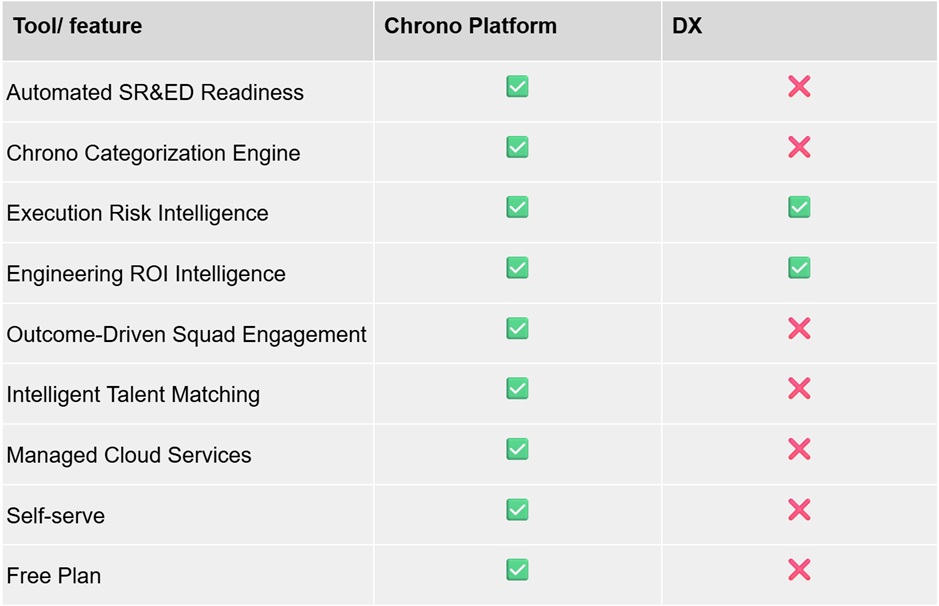
What Is Chrono Platform?
Chrono gives you a clear view of how engineering effort ties back to business results. If you lead a team and need to track delivery, cost, and tax eligibility in one place, this platform saves you hours of manual work. You’ll see how time maps to R&D claims, which projects eat your budget, and where capacity opens up.
This lets you allocate or even reallocate resources mid-sprint with confidence.
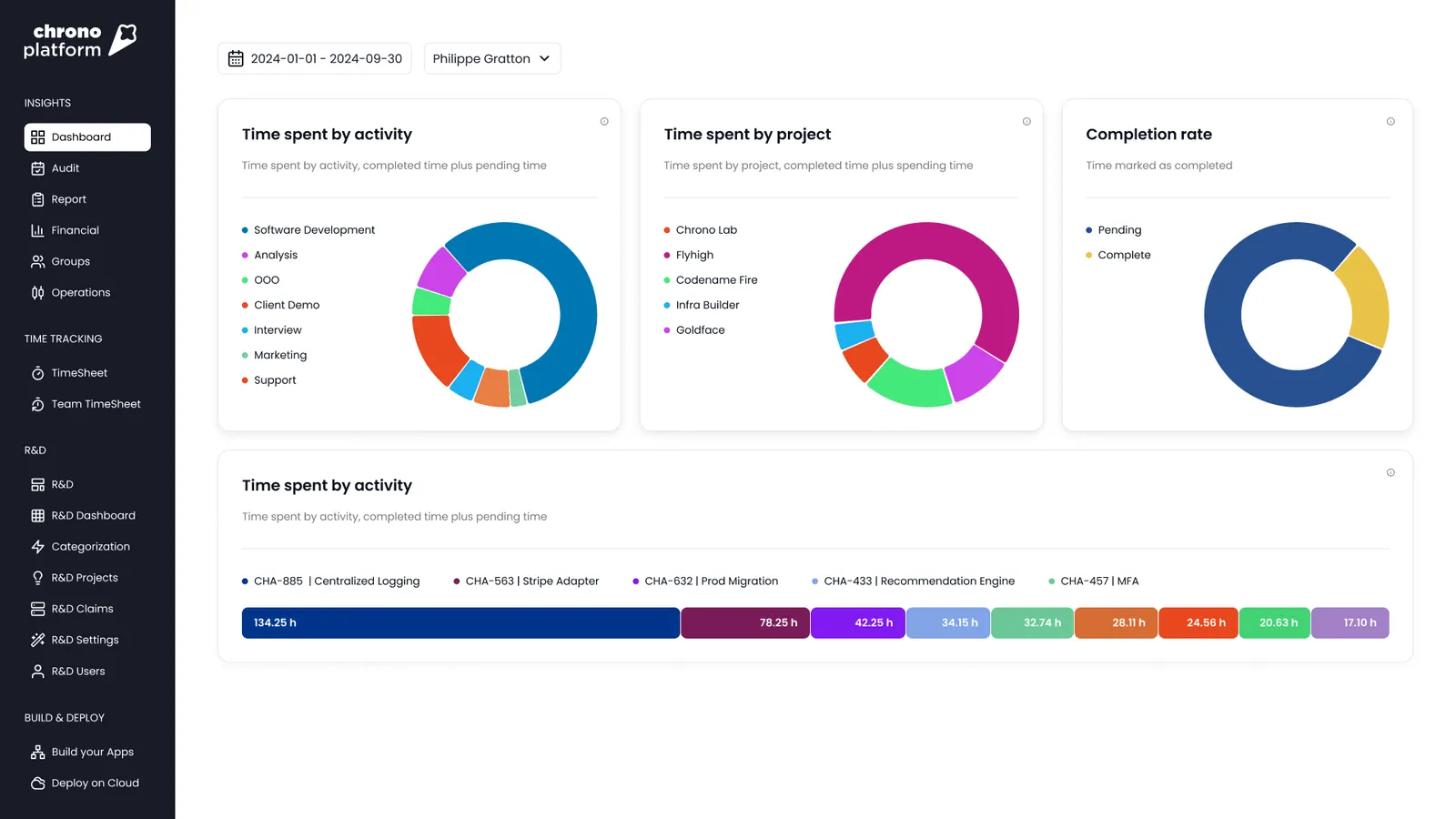
Having this essential data ready without the clutter will help you move faster.
In fact, 64% of firms say improving operations with real-time data is vital, and 77% of organizations using real-time analytics report better financial performance.
That means what you measure and how quickly you act on it can drive both delivery and margin. The question isn’t whether you need real-time insight. It’s whether you need it for financial confidence or team health.
What Is DX?
DX focuses on how developers experience their work day to day. It combines lightweight surveys with backend telemetry to surface patterns like workflow friction, slow code reviews, or onboarding issues. You’ll see metrics such as flow efficiency, handoff delays, review speed, context switching, and time spent waiting versus actively coding. You can even benchmark against industry peers.
Its strength lies in highlighting internal blockers and morale risks before they escalate.
If you’re managing burnout risk or trying to retain top talent, DX helps you monitor and respond in real time. It’s most useful when your focus is less on financials and more on process health. With it, you can use developer experience metrics like flow efficiency, interruptions, and context switching patterns.
Chrono Platform vs. DX: Detailed Comparison
If you're weighing Chrono vs. DX, the real difference shows up in what each platform helps you measure and why it matters to your team. Both aim to improve visibility, but they take very different routes. Below are the key comparisons across these two best engineering intelligence tools today.
Automated SR&ED Readiness
This one’s simple. If you want to automate R&D tax credit claims, Chrono is the only option in this comparison. It connects engineering work to tax-eligible categories using time tracking, rule-based classification, and direct export into claim-ready formats. That means you don’t need to chase engineers for hours or dig through backlogs to figure out what qualifies.
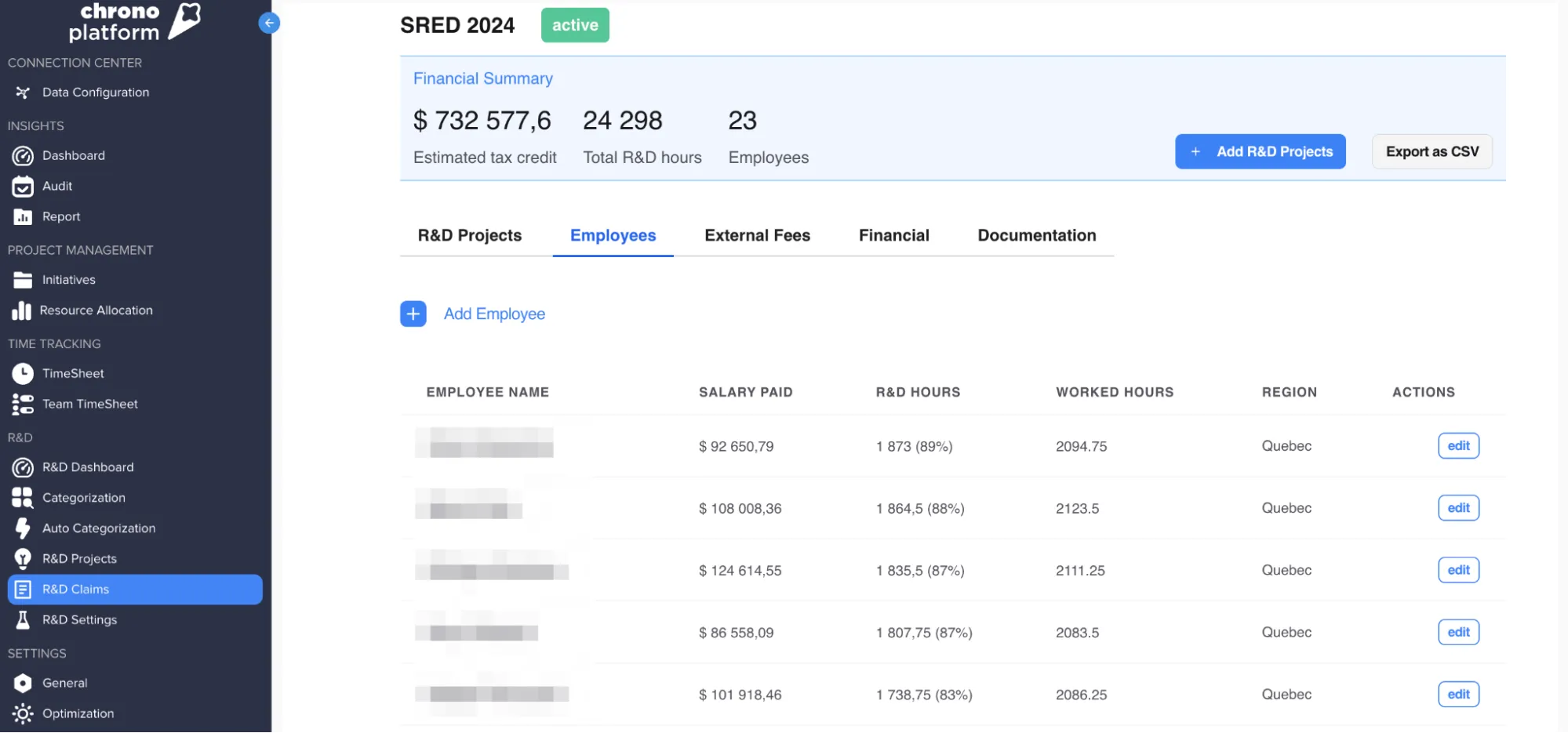
Chrono pulls activity from Jira, calendars, and other tools to surface qualifying work as it happens. You can retroactively adjust classifications when priorities shift or if a project takes a new direction. So when R&D audit season comes, your reports reflect the full scope of eligible work.
DX doesn’t offer anything in this area. If your team does R&D but the claims process is manual or flawed, you’re likely underreporting and overexposing your team to audit risk. It’s much better to have a solid tool with a solid categorization engine for all your R&D activities. Chrono even has reverse categorization.
That brings us to our next point:
Chrono Categorization Engine
Chrono’s categorization engine is based on two main pillars: reverse-engineering time allocation and the ability to reclassify past data according to new rules. Let’s see what these entail:
Reverse Engineered Time Allocation
Chrono doesn’t ask engineers to track their hours manually; instead, it reconstructs their time from the tools they already use. That includes Jira tickets, calendar events, and time spent on tasks linked to delivery goals. You get clean data on where the effort went without disrupting workflows, which means less friction and better reporting.
This matters because what engineers plan to do sometimes doesn't align with where their time actually goes. For example, the typical software engineer spends just 41% of their total work time coding. Chrono makes the other 59% visible, so you can optimize meetings, rework, context switching, and overhead.
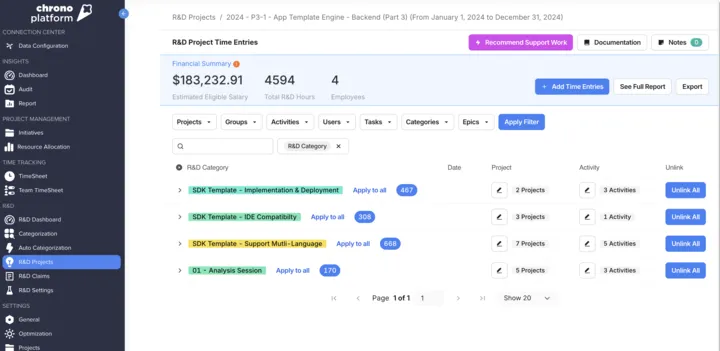
DX doesn’t offer anything comparable. It lacks automatic reconstruction and relies more on user input and fixed activity tracking, which limits the depth and reliability of time analysis.
You can’t fix what you can’t see, and reverse time mapping solves that.
Evolutive Business Rules Categorization
Most platforms freeze your reporting rules the moment you set them. Chrono doesn’t. You can update, modify, or override how work is categorized as priorities shift or R&D eligibility standards change. This feature lets you reclassify historical data based on new tax rules, business models, or internal goals without starting over the audit.
That flexibility is critical if you're working in a fast-moving environment. For example, you might start a sprint under a product delivery initiative, then pivot that work under a research track. Chrono adjusts without forcing you to recode or backfill manually.
It’s like version control for time tracking logic. You get clean, audit-ready data that actually reflects how your business operates in real life, not how it looked on paper six weeks ago.
DX doesn’t support dynamic recategorization. Once data is collected, it stays fixed, so your reporting can drift from how the work actually evolved.
Execution Risk Intelligence
Chrono’s Execution Risk Intelligence connects delivery data, automation signals, and business objectives so engineering leaders can see where execution risk emerges before delays, overruns, or failures escalate.
Every tracked initiative ties to specific delivery goals, budget lines, and (where relevant) R&D tax eligibility.
This means you don’t just see that a project is slipping; you see how that delay impacts revenue forecasts, cost centers, or funding claims.
Chrono integrates delivery tracking with real-time DevOps automation data. CI/CD pipelines, deployment activity, and incident alerts feed into the same view as engineering effort and spend. This lets you identify risk points such as:
- Teams overextended beyond capacity
- Initiatives misaligned with business priorities
- Repeated blockers in deployment or testing
- Infrastructure reliability gaps that could impact delivery speed
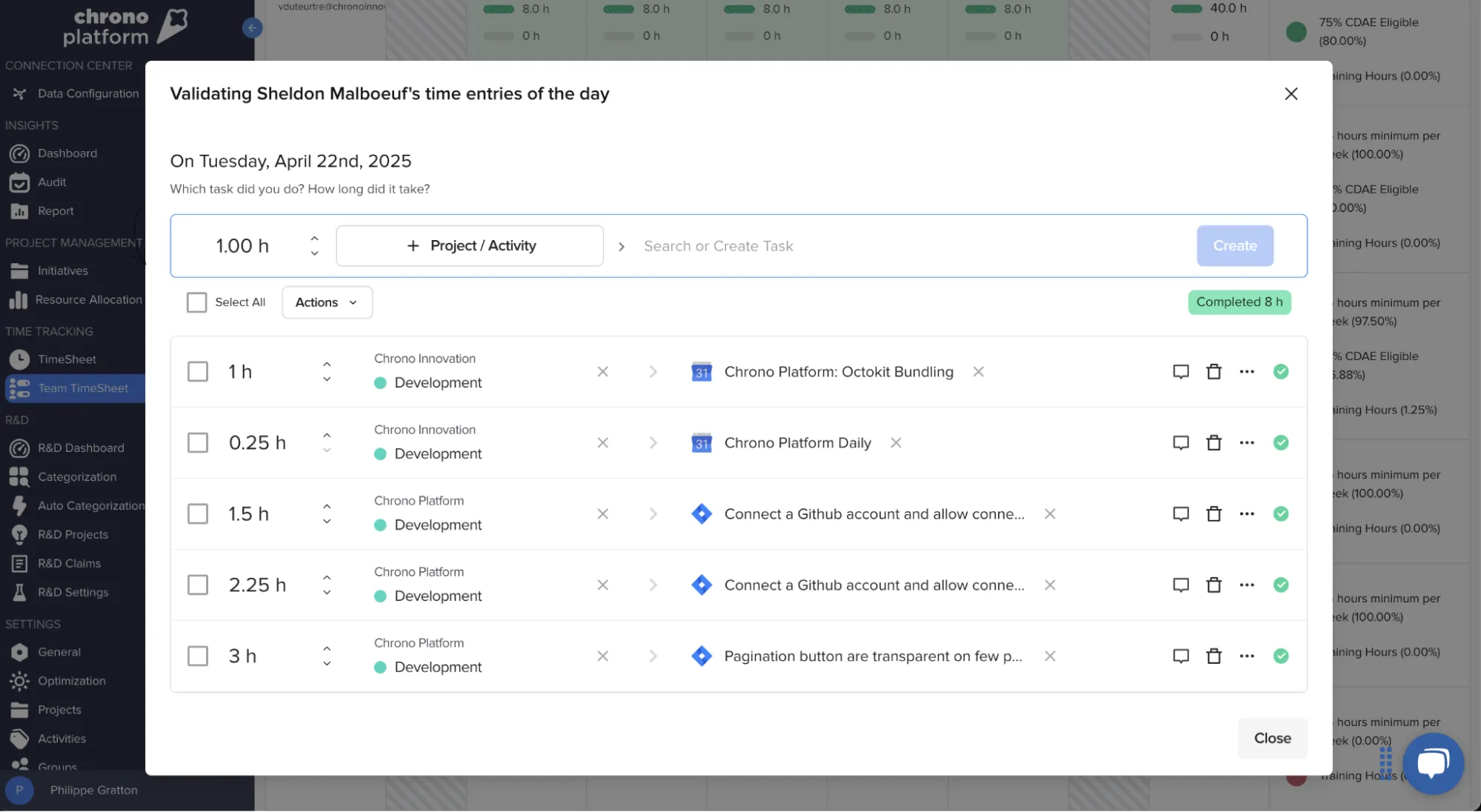
For leaders accountable to the board or CFO, this translates into clear answers: which risks matter most, what’s driving them, and how they affect both near-term delivery and broader business targets.
DX gives you visibility into execution patterns, but it focuses on developer-level signals: flow efficiency, handoff delays, code review speed, deployment frequency, and similar metrics. These help you see friction points that can slow delivery or impact team performance. For team leads or engineering managers, this is useful to spot blockers or process breakdowns early.
However, DX doesn’t connect these signals to business-level execution risk.
It doesn’t tie delivery health to revenue impact, budget exposure, or tax-related reporting. It also lacks integrated DevOps and infrastructure data, so risks linked to automation gaps, deployment stability, or capacity constraints remain outside its view. For leaders accountable for forecasting, financial alignment, and operational targets, this means additional tools (and extra effort) are needed to assemble a complete risk picture.
This leads to all sorts of delays, which aren’t by any means cheap.
One report found that deployments were 26% more likely to be delayed than delivered early. This is costing companies an average of £107,000 or the equivalent of approximately $145,000 per year.
The same report showed that most organizations deploy only once every 29 days, and when delays hit, they add up to 3.8 extra months on average.
Chrono eliminates that fragmentation, combining delivery, DevOps automation, and financial context in a single system built for executive-level decisions.
Engineering ROI Intelligence = Financial Visibility
Chrono gives you a financial layer that DX doesn’t even try to offer. If you’re a VP of Finance, CFO, or even just someone asked to justify tech spend, you can’t afford vague estimates and siloed systems. These lead to missed tax credits, inaccurate forecasts, and a harder time defending budgets to the board.
Chrono connects hours, tasks, and delivery back to cost centers, R&D eligibility, and budget trends. You can trace where engineering effort turns into tax credits or overhead. Also, you’ll see who’s over capacity and which projects are burning more cash than expected.
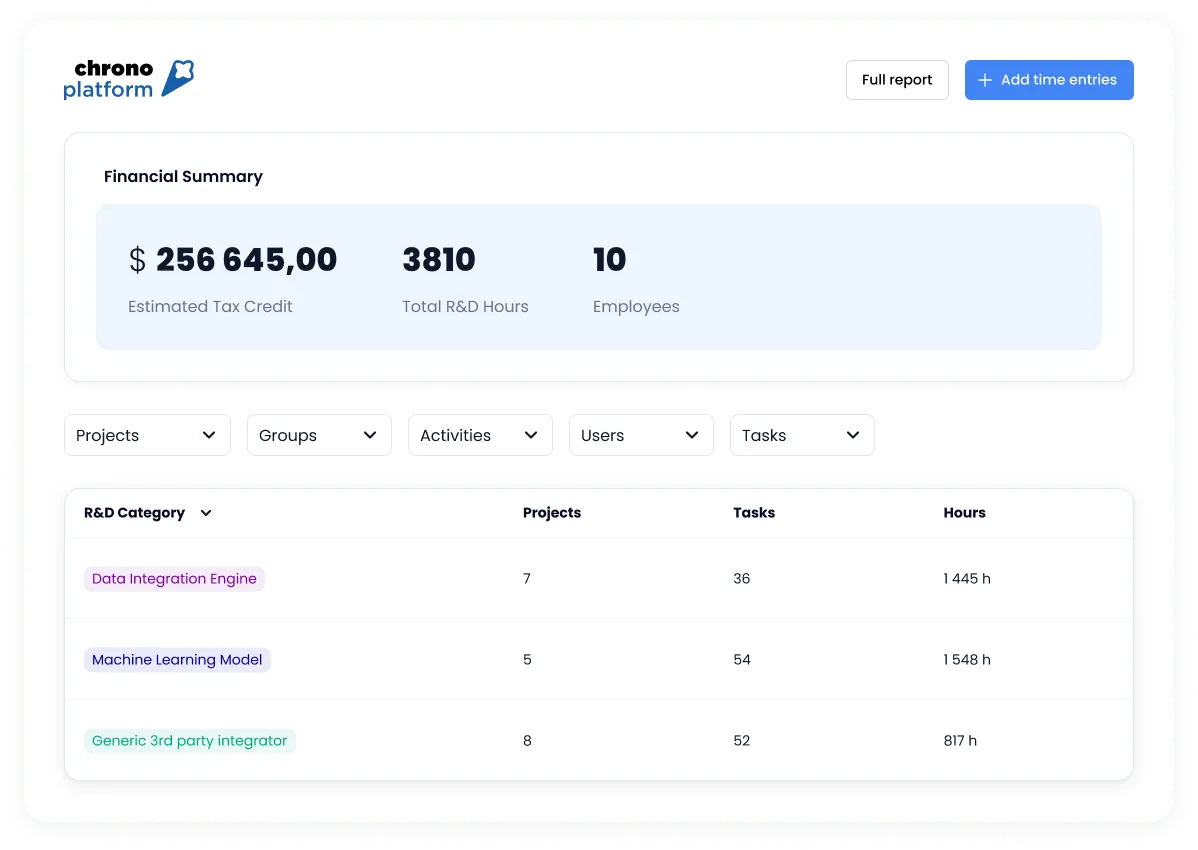
DX skips financials entirely. It’s not a minus, it’s simply just not the job it’s built for. For someone managing headcount against margin targets, that’s a real gap.
And it’s a genuine problem since 40% of CFOs don’t fully trust their company’s financial data, and 37% of small businesses spend 1-3 days just to gather accurate financial figures.
Now, let’s consider this example.
Your team is delivering on time, but costs are creeping higher every sprint. The delivery looks good on paper, but without a clear tie between effort, cost, and output, you’re left guessing where budget leaks are happening.
That’s exactly the kind of visibility gap those 40% of CFOs are facing today. Chrono closes that gap with real-time financial data.
With Chrono, you see exactly where time and effort are going, which projects are consuming more hours than forecasted, where capacity is overextended, and how that impacts overall engineering ROI.
Therefore, you can reallocate resources or adjust scope before budget targets are missed. That’s what connects engineering performance to business value in a way DX simply doesn’t cover.
Outcome-Driven Squad Engagement
Chrono helps you move beyond tracking team activity to understanding whether that activity drives the outcomes that matter. It gives engineering leaders the data to engage squads around delivery goals, business priorities, and measurable impact, not just velocity or task completion.
You can segment by team, project, role, or initiative and see where time is well spent, where overwork starts to erode value, and where rebalancing effort would deliver stronger results. And this helps you run the entire department more efficiently
This also makes cross-functional reporting more precise. Whether you're briefing finance, operations, or execs, Chrono helps frame engineering work in terms of business contribution, without the theorizing or reformatting that slows down communication.
DX focuses on team health and internal flow metrics. While valuable for supporting managers and improving developer experience, it stops short of showing how squad-level work maps to wider business outcomes. That leaves a gap if your role is to connect engineering effort to strategic priorities and justify that alignment.
Intelligent Talent Matching
Chrono closes the loop between execution data and staffing decisions, helping you scale teams with the right skills at the right time. Here’s what you can expect:
Engineering Talent Recruitment
Chrono gives you visibility not just into what’s being done, but also into who’s doing what, and where gaps are forming. It connects performance and capacity data to help you understand where to scale, who’s overloaded, and what kind of skills you actually need next. That makes headcount planning and hiring roadmaps significantly more objective.
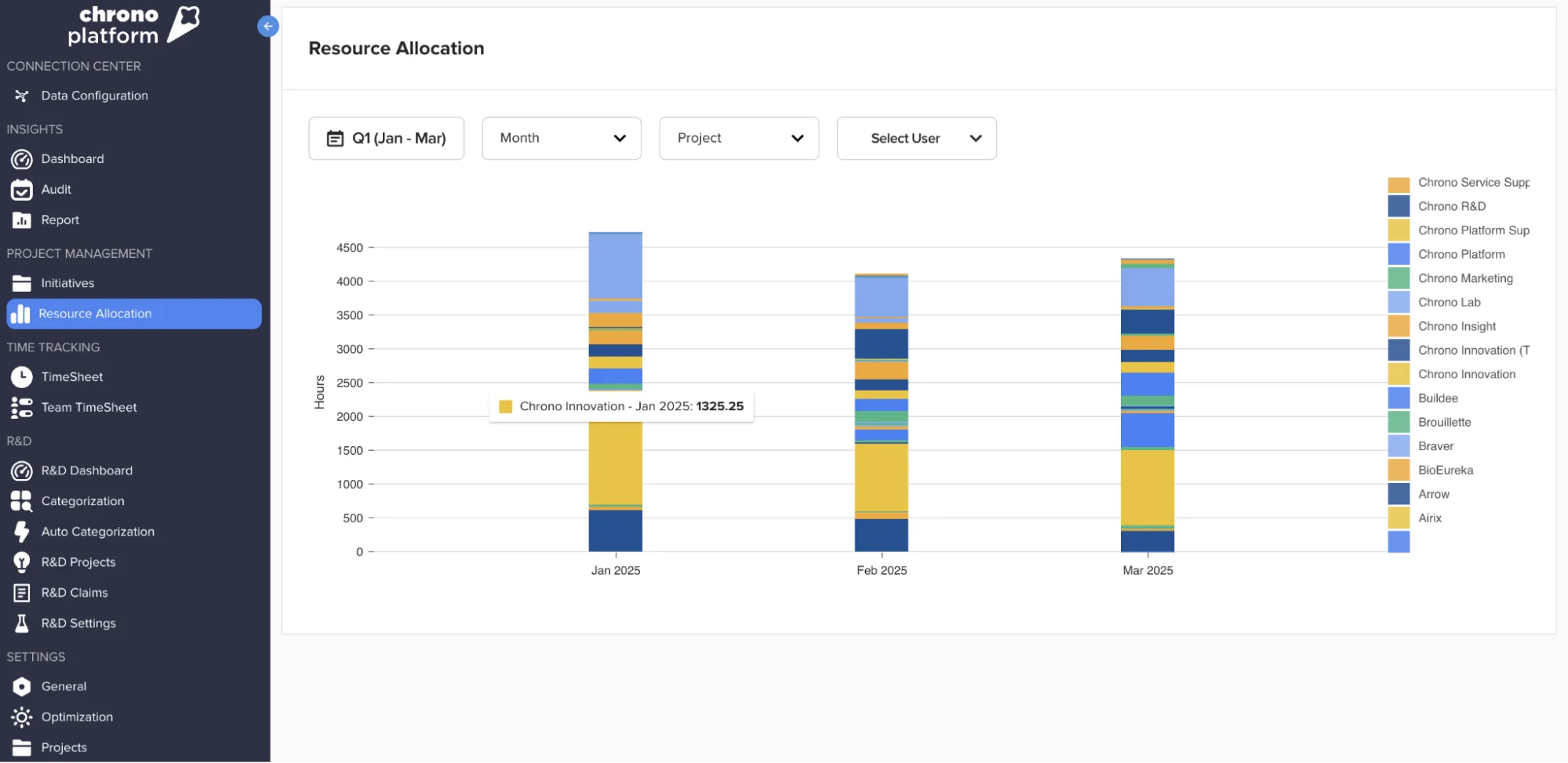
And you need this objectivity because hiring is harder than ever. A SHRM survey of 2,366 HR professionals showed that 37% of companies struggled to fill engineering and architecture roles, and 90% of hiring managers report difficulty sourcing skilled candidates. You can’t afford to hire reactively anymore.
Chrono flips that. It gives you early signals when someone’s consistently over capacity or when project demands outpace available skills. That lets you open hiring conversations early, with the right context and data behind the request.
And when internal capacity signals show gaps, Chrono helps solve this problem. Through its technical recruitment support, Chrono delivers a curated pool of candidates who have undergone rigorous technical and cultural fit evaluations. This ensures that when you need to hire, you’re choosing from talent that’s ready to contribute.
On the other hand, DX doesn’t offer support for recruiting or workforce planning. It doesn’t surface hiring signals, connect performance data to staffing needs, or show you the best candidates for the job.
Software Development Capacity on Demand
One of the biggest hidden costs in engineering is blocked work due to missing capacity. Chrono’s solution is development bandwidth on demand, based on your existing usage data. You can request vetted engineering resources directly from inside the platform, calibrated to the tech stack and capacity need you're trying to solve.
This approach matters more than ever. Over 55% of software projects fail due to inadequate resource planning, often because teams don’t see the crunch coming until it’s too late. Chrono flags those risks early and lets you act fast by providing additional support.
The DX engineering platform doesn’t have functionality in this area.
It tracks what’s happening, but it doesn’t help you solve staffing constraints when they show up. And if you’re scaling quickly or managing multiple roadmaps, having extra capacity when you need it can mean the difference between delivering and slipping another quarter.
Managed Cloud Services
Chrono provides fully managed CI/CD workflows and cloud infrastructure designed to reduce operational load and improve delivery speed. Pipelines are configured for your stack, so your teams can deploy confidently without wasting cycles on setup or maintenance.
Besides, our infrastructure monitoring runs 24/7. We flag anomalies before they escalate, and that’s a critical safeguard when downtime costs can exceed $9,000 per minute, or millions per hour in high-impact sectors.
Chrono also supports AWS, GCP, Azure, and DigitalOcean. This allows you to run multi-cloud or hybrid environments without added complexity. Since your cloud performance, costs, and incidents are visible in one platform alongside engineering delivery data, you won’t have to switch between tools or dashboards.
There are two tiers available:
Startup Tier
- Managed low-cost cluster for early-stage or low-criticality environments
- Uptime checks, basic logs, and standard alerting
- Business-hours incident response for non-critical issues
Scale-Up Tier
- Full cloud infrastructure management (AWS, GCP, Azure)
- 24/7 incident response for production workloads
- Advanced monitoring, alerting, and tailored dashboards
- Direct DevOps support to reduce internal engineering overhead
This setup ensures your infrastructure decisions are tied directly to delivery outcomes and resource usage. You can ship faster, with fewer disruptions, and clearer reporting on where cloud spend supports business value.
DX doesn’t provide managed cloud services or CI/CD support. That means if you need integrated visibility across cloud operations, deployments, and engineering output, DX requires separate tooling, adding complexity when issues arise.
Self-serve
Self-serve platforms let you set up, connect, and start extracting value without relying on lengthy sales cycles, custom integrations, or vendor intervention. For engineering leaders, this means you can validate fit, map data, and see meaningful metrics on your own timeline, not the vendor’s.
Chrono is designed as a self-serve platform.
You can connect tools like Jira, calendars, and code repositories, and start seeing engineering time breakdowns, delivery signals, and cost mappings within minutes. There will be no sales calls or procurement delays with us; you have direct access to test alignment with your workflows in 3 minutes or less.
DX, on the other hand, generally requires a guided setup through their team.
While pilots are possible, they usually involve sales engagement and custom configuration. This limits your ability to independently evaluate the tool’s fit for your engineering organization before committing resources or time.
On the other hand, Chrono’s self-serve model gives you control over the evaluation process and lets you move at the pace that fits your team’s priorities.
Free Plan Available
You can try Chrono for free (up to three users) with full access to its core features. That’s helpful if you want to test how well it maps to your data without needing budget approval or long procurement cycles. You can plug in your calendar, connect Jira, and start seeing engineering time breakdowns within minutes.
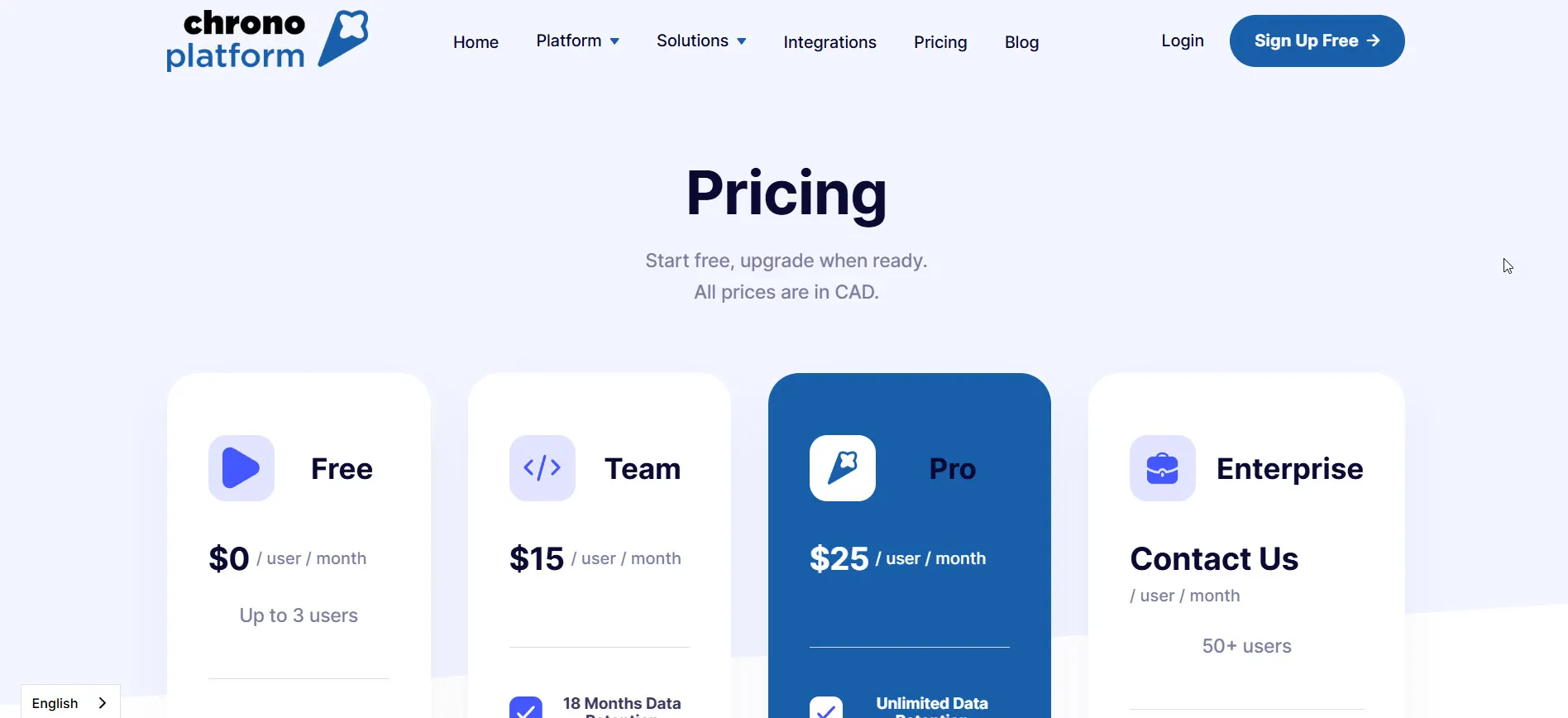
The DX engineering platform, on the other hand, generally runs on a paid model. Pricing isn’t always public, and while pilots are possible, they usually require sales involvement. That’s not a blocker, but it’s something to plan for if you're evaluating both tools side by side.
Free access gives you a low-risk way to validate whether a tool fits your workflows. Chrono knows that, and it’s why the free tier exists.
Chrono Platform vs. DX: Pros and Cons
When you're deciding between Chrono vs. DX, don’t do a feature-by-feature comparison. Think about strategic alignment instead. You need to understand what each platform prioritizes and what that means for your outcomes. Chrono leans heavily into business and operational visibility, while DX zeroes in on team insights.
Here’s a breakdown of where each one stands out and where the gaps begin to show.
Chrono Platform Pros
If you're accountable for results beyond just sprint outcomes (things like R&D funding, project delivery, and departmental performance), Chrono is built for you. It connects engineering effort directly to business value and helps you manage the operation, not just the workflow.
- Automated R&D tax credit optimization saves time and increases claim accuracy. You don’t have to chase teams for eligibility data because it’s already sorted.
- Passive time tracking means engineers don’t have to log hours. You get full visibility without burdening the team.
- You can track and improve the engineering department's efficiency with real performance and allocation metrics.
- Reverse-engineered time allocation shows how work actually happens. This can help you optimize across sprints and roles.
- Evolutive business rule tagging lets you recategorize data as goals or tax standards change. Your reporting always stays aligned.
- Built-in support for hiring and on-demand engineering capacity makes scaling more predictable.
- A free plan gives you a low-risk way to validate the tool using your real data.
Chrono Platform Cons
Chrono gives you depth on business impact, but that’s not what every team needs.
- If your goal is to coach engineers or improve morale tracking, Chrono’s focus on efficiency and alignment might feel too structured.
- Chrono includes optional features like talent recruitment may not add value if your organization already has strong internal HR systems or staffing processes.
DX Pros
DX is straightforward and focused. If you want to focus on how engineers operate and what slows them down, it gives you a refined view without needing layers of setup.
- Strong data on blockers, satisfaction signals, and team delivery patterns.
- Helpful for team leads who want to optimize flow and reduce bottlenecks.
- Sleek dashboards make it easy to read team patterns at a glance.
- Great choice for coaching and feedback rather than ops and financials.
DX Cons
DX is designed more for managers than execs, and that’s where the limitations show up.
- Not ideal if you need Finance or C-suite visibility. It lacks forecasting, budget tie-ins, and tax reporting.
- Relies heavily on surveys and sentiment scoring. That can be limiting if you want a broader data context.
- It can be difficult to configure in teams with custom workflows or tool stacks.
- You may find integration gaps that require manual cleanup or workarounds.
- Individual tracking can backfire if misread by non-technical stakeholders.
- You won’t get financial views, alignment metrics, or optimization features that tie back to strategic outcomes.
When you need clarity across budget, performance, and delivery, Chrono ranks higher among the best engineering intelligence tools. If you’re managing team satisfaction alone, DX keeps it simple. But once business impact enters the conversation, simplicity may not be enough.
Final Verdict: Which Platform Should You Choose?
If you're leading engineering with budget ownership, delivery targets, and R&D goals on your plate, Chrono gives you the control and visibility you need. It shows where time and money go, flags delivery risks early, and helps you reclaim tax credits, all in one workflow.
DX gives you value if your focus is team-level patterns and morale tracking, but it stops short when strategic or financial decisions come in.
Chrono is free for up to three users, so you can plug in your own data and test it now (no sales call needed). Try it yourself or book a demo to go deeper.



